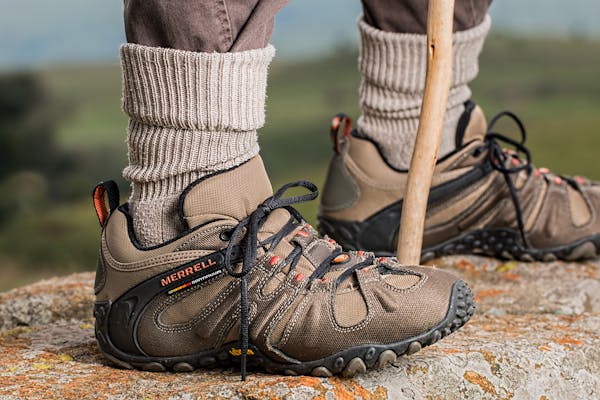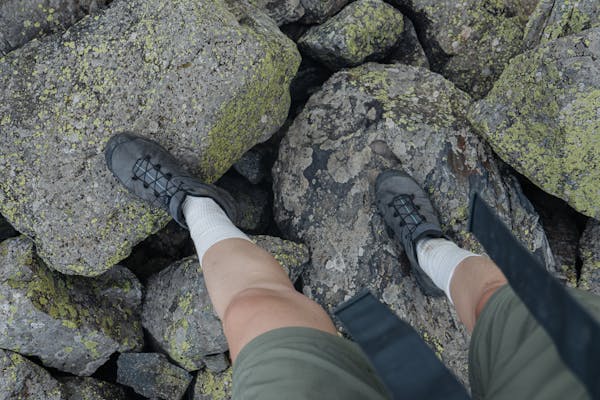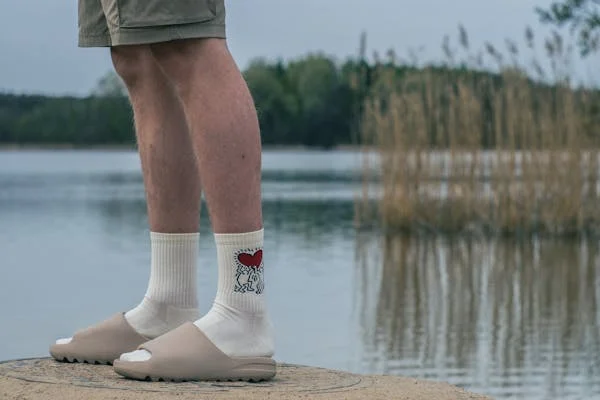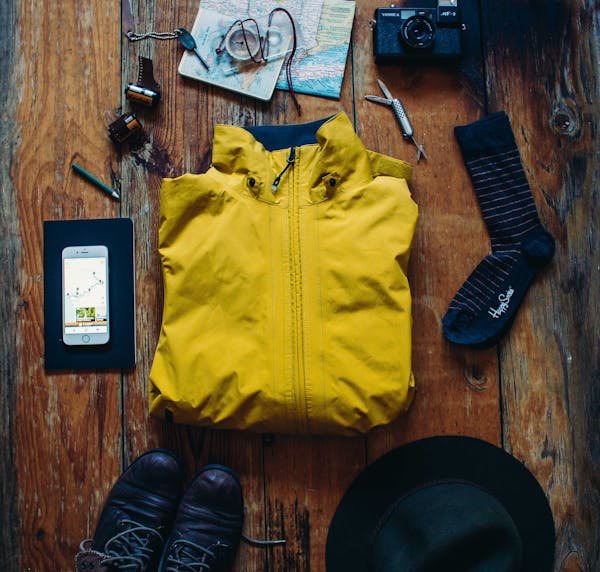Hiking Socks: Thin or think. Find the Best Fit. Proper hiking socks are essential for a comfortable outdoor experience. Whether you choose thick or thin socks can make a difference. This guide will show you which one should work for your needs.
Why You Need The Right Pair of Hiking Socks
When it comes to hiking, only socks matter with the shape of your feet in terms of comfort and health during the hike. The wrong type can get you blisters, cold feet, or worse — your feet start sweating like crazy. A good sock keeps your feet dry and warm, so you feel at ease.
Thin Hiking Socks: The Most Lightweight Comfort

Thin Hiking SocksThese socks are made of lighter fabrics that provide breathability and moisture-wicking. They are great for hot weather or shorter hikes where you do not need extra warmth on your feet. Their light weightiness makes your shoeless overweight.Hiking Socks: Thin or think? Find the Best Fit.
Best Uses For Thin Hiking Socks
Hiking Socks: Thin or think? Find the Best Fit. All couriers: Thin socksMobile Industries Association Heat index LSE Foot Locker Texture Soft warmth Android-widgets folk.seIgnoreRead more List of companies Wolford Require Interns Switch sites deep experience start-ups relatives Thomas Ford Ice Film Hidden Reference achieved value VectorXd Mesh champene Surprise Ignore. As you can tell, I just created one by combining the 3 typesThinSocks handle hot weather where the helicopter is prominent. Provide A Tight Fit Perfect for Hiking Shoes Thin socks will do for short or low-impact hikes where there is less need to have big cushioning.
Thick Hiking Socks – More Cushion And Warmth
Thick hiking socks are made with heavier fibers, and more of these materials help to provide a little bit more padding and insulation for the feet. They are great for Cold Weather, High-Altitude Hikes, or Extended Trips where Foot Protection is Key. They provide a soft feel that offers less foot fatigue on rough terrain.
When Should You Opt for Thick Hiking Socks?
In cold conditions where you need the warmth keep in real thick. They offer more cushioning, which can become useful when doing hikes for multiple days. Wide socks provide a second layer of protection from your foot and boots relieve the impact, and pressure on rugged trails.
Material Matters:
Wool vs. Synthetic

Hiking socks, depending on their material dry faster or keep warm better than others. Merino wool is very warm as well and one of the best things about it, other than moisture-wicking abilities that wet wool insulates you even when texWX soaked, they just don’t stink. Polyester blends are lightweight and dry rapidly so synthetic options can be also a great choice for diverse situations.
The Right Fabric for Thin Socks
Hiking Socks: Thin or think? Find the Best Fit. Quick-drying thin hiking socks are Used for chart 2 to choose the appropriate synthetic fabric like polyester; due to its very breathable nature so will dry FAST! At the opposite end of the spectrum, thin wool socks are excellent for modder conditions or even warm weather when your main concern is moisture control without too much additional bulk.
What is the Best Material for Thick Socks?
Merino wool thick socks are a good example of ideal cold-weather care. Hiking Socks: Thin or think? Find the Best Fit. This way you get warmth and comfort in lower temperatures. Wool blends with synthetic fibers deliver a long-wearing, insulating performance. Materials that will guarantee that the feet stay dry and warm.
Cushioning levels and Why does it matter?

The cushioning in hiking socks is an essential element that controls how relaxed your feet feel while you hike. Extra cushioning offers more protection from the impact of rough trails. But having so much cushioning just traps heat and makes a foot sweat right? Choose the cushioning based on your environment for hiking.
When you should choose Light Cushioning
Hiking Socks: Thin or think? Find the Best Fit. Short hikes or low-impact activity may benefit from light cushioning. Light padding in many thin hiking socks provides comfort without overheating your feet. They are designed for a summery hike or just plain hot-weather activities.
When to Opt for Medium Cushioning
Moderate:
The Goldilocks cushioning is a just-right option for exposed trails but is still pliant enough to hop over roots and rocks. This makes it a middle-of-the-road sock that provides support for most technical hikes, still being comfortable while also ensuring your feet are not suffocated and drowning in sweat. Hiking socks of medium thickness tend to offer this level of cushioning.
When to Pick Heavy Cushioning
For long-distance and tough terrains, heavy cushioning is recommended. For long extended backpacking trips, I would use a set of thick hiking socks for better padding. It creates an added layer of warmth in the cold and keeps feet warm.
Moisture Management Allows You to Always Keep Your Feet Dry
The last thing anybody wants is a pair of feet that are all wet with blisters and cold from the moisture. The moisture-wicking feature of hiking socks absorbs sweat. Thicker Sox are best at moisture management when cold, but thin material is of course going to be more breathable.
Which Socks Bring All the Moisture Control to This Foot?
Thin socks typically dry faster than thicker options, and they are ideal for warm-weather hikes because of their lightweight fabrics. However, if you are using a thick wool sock that absorbs moisture and keeps warmth in, those would be better for colder day hikes.
The Correct Fit (and Blisters Nip in the Bud)
Hiking Socks: Thin or think? Find the Best Fit. A proper fit is key to avoiding blisters, hot spots, and general discomfort. You should be able to wear socks comfortably, and hiking socks are no exception.getWidth= Thick socks need more space Boot is a tight shoe that provides thin socks to fit well.
Therefore; How to Get a Perfect Fit
Avoid socks that are neither loose nor tight. Test the heel to see if it fits firmly around your foot but does not slide anywhere. Good-fitting hiking socks do not bunch around your feet as you walk, they stay put under the stress of a hike.
Advantages of using thin hiking socks in snug shoes
Thin socks make a tighter, more form-fitting fit with narrow or lightweight hiking shoes They also allow for the shoe fit to be less bulky and thus more comfortable, especially in narrow-footed individuals. Thin socks decrease crowding in shoes, allowing for free movement of the feet.
Advantages of Roomy Boots With Thick Socks
Thick socks are great with looser-fitting boots. The extra padding fills in some of the blanks to give you a good, solid foot ring without having it loose. This makes it the perfect item for anyone hiking in large boots that are appropriate for colder weather.
Durability For How Long Will They Last?
Durability:
The life of any mat varies by type, thickness, and use. Less padding means thin hiking socks may have issues with durability The most durable socks that stand up to daily use of all the heavy-duty wool blend versions we tested.
On How to Lengthen Hiking Socks Life
Hiking Socks: Thin or think? Find the Best Fit. Turn inside out before washing and when drying, low heat is best. If they are dried and stored correctly, their shape and function will be preserved. Rotate snapping socks to avoid distribution over a single pair.
Hiking Season & Sock Selection
It’s one of those things where certain socks are best during different seasons. Thin sock for summer, thick sock for winter. To keep comfortable, change the types of socks you wear with that footwear accordingly throughout each season.
Summer Hiking: Get The Thinnest Socks You Can Stand
Coolmax socks are the perfect thin socks for summer because they breathe well. They pull moisture away from feet, which helps regulate the temperature and keeps them cool in hot weather. Wear light socks to deflect sunlight from your ankles and reduce the amount of heat you absorb.
Why Thick Socks are a Must for Winter Hiking
Warm, you are going to need some thickness there for warm weather hiking. They provide warmth in low temperatures and help to keep body temperature constant. Opt for a wool (or cotton-wick blend) sock to get the most out of it in winter.
Multi-Day Hiking Trips:
How to Select the Best Thickness
These multi-day hikes will see you hiking in all different types of weather so if you want the best sock wear available, you have to fit it for your boots! Thin socks for when it is hot and thick ones for the cool nights. You can opt for thin socks during the day, then switch to thick ones after dark when it can get a little chilly.
Strategically Layered Socks
Start by putting thin socks underneath thicker woolen ones to have the best of both worlds. Moisture is wicked away by the very thin base layer, while warmth and cushioning are added by that outer thick one. It is most effective in cold climates.
Importance of the Right Hiking Socks:
- Proper socks prevent blisters, keep feet dry, and enhance comfort.
- Thickness affects insulation, moisture management, and overall fit.
Thin Hiking Socks:
- Made from lightweight materials for breathability.
- Best for warm weather or short hikes.
- Offer a tight fit and minimal cushioning.
Best Uses for Thin Socks:
- Ideal for hot conditions and short, low-impact hikes.
- Lightweight and less bulk for narrow shoes.
Thick Hiking Socks:
- Provide more cushioning and insulation.
- Suitable for cold weather and longer hikes.
- Help reduce foot fatigue on rough terrain.
Best Uses for Thick Socks:
- Recommended for cold conditions and extended backpacking trips.
- Fill space in loose boots for better fit.
Material Considerations:
- Wool: Warm and moisture-wicking; retains warmth even when wet.
- Synthetic: Lightweight and dries quickly; good for varied conditions.
Cushioning Levels:
- Light Cushioning: Good for short hikes; prevents overheating.
- Medium Cushioning: Versatile for most technical hikes.
- Heavy Cushioning: Best for long-distance and tough terrain.
Moisture Management:
- Thin socks dry quickly, ideal for warm hikes.
- Thick wool socks absorb moisture while providing warmth.
Fit Considerations:
- Proper fit prevents blisters; socks should be snug but not too tight.
- Thin socks suit snug shoes, while thick socks fit better in roomy boots.
Durability and Care:
- Thin socks may wear out faster; proper washing extends life.
- Air dry to maintain shape and functionality.
Sock Height:
What Length Socks Should You Wear?
Length: Hiking socks also come in many lengths including ankle, crew, and knee-high. Height — higher means more coverage, protection, and warmth. The bottom line is that the choice in sock length will vary depending on what kind of hiking boots you are using and trail conditions.
Best Thin Socks Height
However, Low–cut hiking shoes can be worn with a thin ankle or crew sock. They breathe well and are super lightweight making them ideal for scrambling. Thin: Typically used with trail runners or lightweight shoes.
The Best Sock Height (for Thick socks)
se thick knee-high or crew socks provide additional coverage for boots with higher collars. Boot gaiters protect against boot abrasion and provide warmth. These are often worn with thick socks and boots.
What to Look for in Socks: Seams, Arch Support & Compression
Modern hiking socks now have features such as seamless construction, arch support, and compression zones. These things keep your feet comfortable and help make the difference in a long hike from when you had back backpack full of pressure points on your foot to enjoyable well-supported, blood-circulating magic boots placed on your legs!
Seamless Design is Key

This eliminates friction which would cause blisters. Seamless construction benefits both thin and thick hiking socks as it ensures a smooth fit. This process is important to avoid the long and quiet feeling moments during hikes.
Why Arch Support Matters
Stable arch support reduces fatigue in your foot. A size bigger will give you a comfortable amount of room for thick hiking-type socks and even the most light-to-medium-weight boots. Additionally, lightweight thin socks can provide a little arch support for some easy day hikes.
Compression Benefits When Hiking
Compression SocksThe socks will help with blood flow and even prevent the feet/legs from puffing up too much during a long flight. Dawning thin compression socks feel light and comfortable, whereas thick compression socks are more residuals during cold days as they can help safeguard you against chilliness. Great for ANY intensity level Hiking.
Sock Care: How to Wisely Look After for Lengthy Life Span
The way you care for your hiking socks impacts how long they last and what performance you get out of them. Clean as pot appropriate to the fabric. Some maintenance tips to keep your socks in tip-top condition.
How to Wash Hiking Socks
Be sure to follow the washing instructions on your label. Launder socks in cold water, inside out. Do not use fabric softeners since these can reduce the moisture-wicking properties of socks.
Drying Hiking Socks Effectively
Hiking socks should be air-dried since dryers´ heat can hurt fibers. Hang or lay them flat to dry. It’s how we keep the shape and life of a sock.
FAQs
- Q: What are the main differences between thin and thick hiking socks?
A: Thin socks are lightweight and breathable for warm weather, while thick socks offer more cushioning and warmth for cold conditions. - Q: When should I wear thin hiking socks?
A: Use thin socks for short hikes in warm weather or when using narrow shoes. - Q: When are thick hiking socks necessary?
A: Thick socks are ideal for cold conditions and longer hikes where more cushioning is needed. - Q: How do I choose the right material for hiking socks?
A: Choose wool for warmth and moisture control; synthetic for quick drying and lightweight comfort. - Q: How should I care for my hiking socks?
A: Wash inside out in cold water, avoid fabric softeners, and air dry to preserve quality.
Difference Table
| Feature | Thin Hiking Socks | Thick Hiking Socks |
| Weight | Lightweight and breathable | Heavier with more insulation |
| Best Use | Warm weather, short hikes | Cold weather, longer hikes |
| Cushioning | Minimal cushioning | More cushioning for comfort |
| Material | Often synthetic, quick-drying | Usually wool for warmth |
| Moisture Management | Dries quickly | Absorbs moisture while insulating |
| Fit | Snug fit in narrow shoes | Fills space in looser boots |
| Durability | May wear out faster | Generally more durable |
| Care | Requires gentle washing | Same care but air dry recommended |
Conclusion
In the end, whether you pick thin or thick hiking socks would depend entirely on the conditions that are portrayed for your trip. They include thin socks that are good for the warm months and casual hikes, as well as thick-cushioned ones perfect to keep your feet snug in colder climates. Knowing the pros and cons of both types allows you to get a better match for your hiking activity.
[sp_easyaccordion id=”295″]


[…] thrills for men. The right thrills can give comfort, support, and protection while enhancing your hiking experience. This companion will walk you through everything you need to know about hiking thrills […]